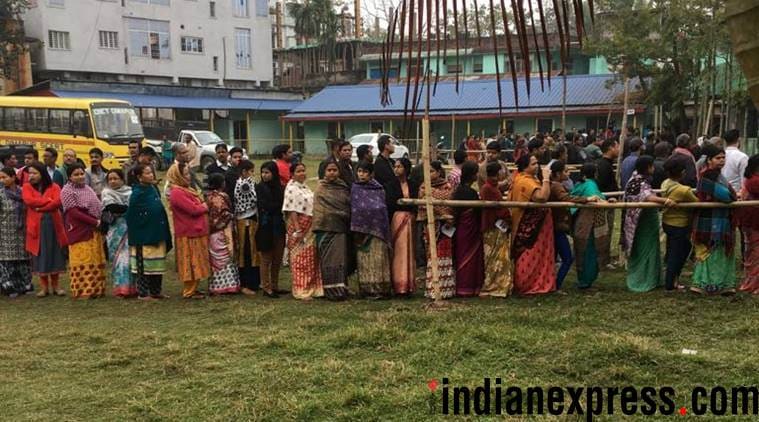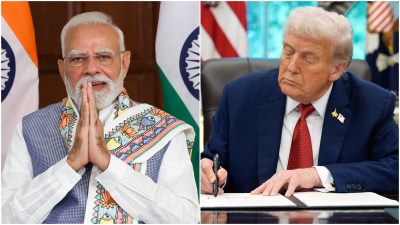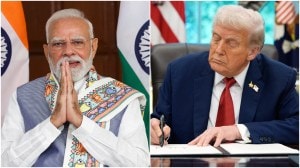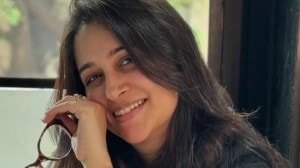Nagaland elections: Month after boycott spectre, state awaits Zeliang v Rio Super Saturday
While NPF has concentrated on a regional identity in this election, positioning itself as champions of Nagas and blaming Rio for instability in the state, the NDPP-BJP alliance has tried to usurp the role of opposition, calling Zeliang “a weak leader”, with the slogan “Change is Coming”.
 Chief Electoral Officer Abhijit Sinha said that at last count — at around 4.30 pm, half-an-hour after the scheduled close of voting — the polling percentage stood at 75, and likely to go up. (Kallol Dey)
Chief Electoral Officer Abhijit Sinha said that at last count — at around 4.30 pm, half-an-hour after the scheduled close of voting — the polling percentage stood at 75, and likely to go up. (Kallol Dey)
A MONTH after representatives of all political parties in Nagaland expressed solidarity with civil society groups and announced that they will not contest elections before the Naga political issue is resolved, before they subsequently withdrew the boycott call, Assembly polls wound up in the state on Tuesday with nearly 75 per cent voter turnout. Chief Electoral Officer Abhijit Sinha said that at last count — at around 4.30 pm, half-an-hour after the scheduled close of voting — the polling percentage stood at 75, and likely to go up.
In 2013, polling was recorded at 90 per cent, and in 2008 it was around 86 per cent. In 2014 Lok Sabha elections, the state recorded 88 per cent voting. Asked why the numbers were relatively low this time, Sinha told The Indian Express, “At this point, it is difficult to tell the number has dropped.”
The election is largely being seen as a battle between Chief Minister T R Zeliang of NPF, and his predecessor Neiphiu Rio, then of the NPF but now heading his own party — NDPP — in alliance with the BJP. While NPF has concentrated on a regional identity in this election, positioning itself as champions of Nagas and blaming Rio for instability in the state in his dalliances with the Centre, the NDPP-BJP alliance has tried to usurp the role of opposition, calling Zeliang “a weak leader”, with the slogan “Change is Coming”.
Smaller parties such as the NPP, JD(U), a dwindling Congress, and Independents could prove kingmakers in the event of a fractured mandate.
For some voters, the sharp division between Rio and Zeliang is giving rise to an opportunity. Kieso Kronu, a voter in Northern Angami 1, said, “We have always had politics where everyone is greedy for power and merges with the government. With how these parties are attacking each other (this time), and NDPP having campaigned in partnership with BJP, hopefully there will be a government and an opposition after the elections. What Nagaland needs most is a functioning democratic system, and an Opposition that raises issues of misgovernance when such issues do emerge.”
One political analyst said, “At the moment the NDPP-BJP seems to be ahead in districts in south Nagaland, while NPF seems to be nosing ahead in areas such as Phek and Mokukchung. The key will be Mon and Tuensang, where PM Narendra Modi addressed rallies.”
The election has also seen a debate on the influence of BJP in a Christian-majority state, with the Nagaland Baptist Church Council taking a stance against the saffron party. But Mhonlumo Kikon, the party candidate contesting from Bhandari, said, “This propaganda (of the church) will not work because voters will not buy it; only political activists talk about it. There is little discussion about Christianity on the ground. People are only asking, what will you do for me if you are elected?”
Yet, these were also elections that almost never happened. Twenty years after an August 1997 ceasefire with NSCN(IM), and two years after the announcement of a Framework Agreement for Talks amid much fanfare, tribal groups, civil society and student organisations had led a call for “Solution Before Election”, which had then been backed by political parties in a rare consensus. But with the date of nomination getting closer, all the parties, one after the other, backtracked —- their candidates filed nominations, most of them on February 7, the last day.
Grace Sema, a 22-year-old voter in Kohima who had supported “Solution before Election”, said, “Ideally we would have wanted a solution before the election. But now that the elections are taking place (today), this isn’t really about our identity. That is a long, complex problem. This, now, is about our roads, our healthcare, our schools and our future. The talks will and must go on, but in the meantime we need a government that cares.”




- 0111 hours ago
- 0211 hours ago
- 031 hour ago
- 0411 hours ago
- 0511 hours ago

























